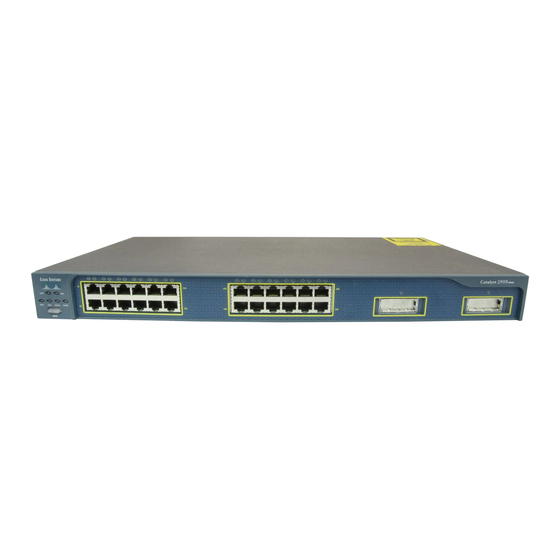Cisco 2950C-24 - Catalyst Switch - Stackable Lembar data - Halaman 8
Jelajahi secara online atau unduh pdf Lembar data untuk Beralih Cisco 2950C-24 - Catalyst Switch - Stackable. Cisco 2950C-24 - Catalyst Switch - Stackable 19 halaman. Catalyst 2950 series switches with enhanced image software
Juga untuk Cisco 2950C-24 - Catalyst Switch - Stackable: Buletin Produk (3 halaman), Buletin Dukungan Produk (5 halaman), Panduan Migrasi (25 halaman)

Feature
Benefit
Support for dynamic VLAN assignment through implementation of VLAN Membership Policy Server (VMPS) client
provides flexibility in assigning ports to VLANs. Dynamic VLAN enables fast assignment of IP address.
SPAN support of Intrusion Detection Systems (IDSs) to monitor, repel, and report network security violations
Cisco Network Assistant Software Security Wizards ease the deployment of security features for restricting user access
to a server, a portion of the network or access to the network.
Quality of Service (QoS)
Cisco Catalyst 2950 Series switches support the aggregate QoS model by enabling classification, policing/metering,
Overview
and marking functions on a per-port basis at ingress and the queuing/scheduling function at egress.
The switches support configuring QoS ACPs on all ports to ensure proper policing and marking on a per-packet basis
using ACPs. Up to four ACPs per switch are supported in configuring either QoS ACPs or security filters.
Auto-QoS greatly simplifies the configuration of QoS in VoIP networks by issuing interface and global switch
commands that allow the detection of Cisco IP phones, the classification of traffic, and egress queue configuration.
The switches support QoS classification of incoming packets for QoS flows based on Layer 2, Layer 3, and Layer 4
QoS
fields.
Classification
The following Layer 2 fields (or a combination) can be used for classifying incoming packets to define QoS flows:
Support at
source/destination MAC address, or 16-bit Ethertype.
Ingress
The switches support identification of traffic based on Layer 3 type of service (ToS) field DSCP values.
The following Layer 3 and Layer 4 fields (or a combination) can be used to classify incoming packets to define QoS
flows: source/destination IP address, TCP source/destination port number, or UDP source/destination port number.
Support for metering and policing of incoming packets restricts incoming traffic flows to a certain rate.
QoS Metering
The switches support up to six policers per Fast Ethernet port, and 60 policers on a Gigabit Ethernet port.
and Policing
at Ingress
The switches offer granularity of traffic flows at 1 Mbps on Fast Ethernet ports, and 8 Mbps on Gigabit Ethernet ports.
The switches support marking and remarking packets based on the state of policers and meters.
QoS Marking
The switches support marking and remarking based on the following mappings: from DiffServ Code Point (DSCP) to
at Ingress
802.1p, and 802.1p to DSCP.
The switches support 14 well-known and widely used DSCP values.
The switches support classifying or reclassifying packets based on default DSCP per port. They also support
classification based on DSCP values in the ACL.
The switches support classifying or reclassifying frames based on default 802.1p value per port.
The switches support 802.1p override at ingress.
Four queues per egress port are supported in hardware.
QoS Scheduling
The WRR queuing algorithm ensures that low-priority queues are not starved.
Support at
Egress
Strict-priority queue configuration via Strict Priority Scheduling ensures that time-sensitive applications such as voice
always follow an expedited path through the switch fabric.
The switch offers the ability to limit data flows based on MAC source/destination address, IP source/destination address,
Sophisticated
TCP/UDP port numbers, or any combination of these fields.
Traffic
The switch offers the ability to manage data flows asynchronously upstream and downstream from the end station or on
Management
the uplink.
Important notices, privacy statements, and trademarks of Cisco Systems, Inc. can be found on cisco.com.
© 2004 Cisco Systems, Inc. All rights reserved.
Page 8 of 18
